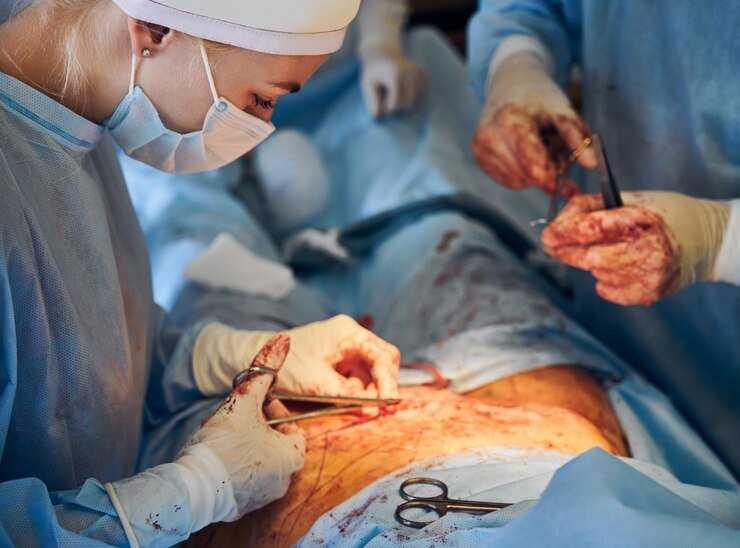Laparoscopic GI Surgery
LAPAROSCOPIC GI SURGERY
Laparoscopic GI Surgery refers to minimally invasive procedures performed on the gastrointestinal (GI) system using laparoscopic techniques. This advanced surgical approach involves making small incisions through which a laparoscope (a thin tube with a camera) and specialized instruments are inserted.

Here are the top 6 Steps Involved in a Laparoscopic Gi Surgery:
Patients undergo thorough preoperative assessments and preparations, including fasting and medical evaluations.
General anesthesia is administered to ensure the patient is unconscious and pain-free throughout the procedure.
Small incisions are strategically made to allow the insertion of a laparoscope (camera) and specialized instruments.
Carbon dioxide gas is introduced to create a workspace within the abdominal cavity, providing better visibility and space for the surgical instruments.
The surgeon utilizes the laparoscope and instruments to perform the GI surgery, whether it involves the stomach, intestines, gallbladder, or other organs.
After completing the necessary procedures, the instruments are removed, and the small incisions are closed. Patients are then monitored during the initial recovery period.

Shoulder Pain
Some patients may experience shoulder pain, which is often referred pain from the gas used to inflate the abdomen during surgery. This pain typically subsides within a few days..
Laparoscopic GI Disease Symptoms
After laparoscopic GI surgery, patients may experience pain, swelling, fatigue, nausea, changes in bowel habits, shoulder pain, and incision site discomfort. Follow postoperative care instructions.

Pain and Discomfort
Patients may experience some pain or discomfort at the incision sites. This is typically managed with pain medications prescribed by the surgeon.

Swelling and Bruising
Mild swelling and bruising around the incision sites are common. This is a normal part of the healing process and usually resolves over time.

Fatigue
Feeling tired or fatigued is normal after surgery. It’s important for patients to get adequate rest and gradually resume normal activities as advised by their healthcare provider.

Nausea and Vomiting
Some patients may experience temporary nausea or vomiting after surgery. This can be a side effect of anesthesia or pain medications.

Changes in Bowel Habits
Depending on the type of GI surgery, patients may experience temporary changes in bowel habits. It’s common to have constipation or, in some cases, diarrhea in the initial days after surgery.
The Pros of Laparoscopic Gastrointestinal (GI) Surgery
Explore the latest technologies and techniques contributing to the evolution of laparoscopic GI surgery.
Delve into the differences, benefits, and drawbacks of laparoscopic GI surgery in comparison to traditional open surgery.
Examine the postoperative recovery process and outcomes for patients undergoing various laparoscopic GI surgeries.
Discuss the specialized training and skill set required for surgeons to proficiently perform laparoscopic GI procedures.
Investigate the role of robotic-assisted surgery in enhancing precision and outcomes in GI procedures.
Analyze the economic aspects, including healthcare costs and resource utilization, associated with laparoscopic GI surgery compared to open surgery.
Explore the importance of educating patients about laparoscopic GI surgery, including benefits, risks, and recovery expectations.
Highlight recent research findings and ongoing studies that contribute to the advancement of laparoscopic GI surgical techniques and patient care.
Best Laparoscopic GI Surgery Surgeon in Kolkata | Dr. Pallab Saha
Dr. Pallab Saha, a renowned laparoscopic GI surgery expert in Kolkata, offers advanced and compassionate care
Best Laparoscopic GI Surgery Surgeon in Kolkata

Highest Success Rate
Experience the highest success rates in laparoscopic GI surgery with Dr. Pallab Saha, a leading expert in Kolkata. Exceptional care guaranteed.

Certified Laparoscopic GI Surgery
Certified laparoscopic GI surgery indicates that a surgeon has completed specialized training and received certification in performing gastrointestinal surgeries using laparoscopic techniques.

Premium Laparoscopic GI Surgery
Experience premium laparoscopic GI surgery with advanced techniques and personalized care, ensuring optimal outcomes.
Frequently Asked Questions
Explore simplified insights on Laparoscopic GI Surgery and health topics. From benefits to types of laparoscopes, discover easy-to-understand information for all your queries.
Laparoscopic GI surgery involves a surgeon using advanced tools with a tiny camera to explore inside the body through small cuts. The surgeon sees a magnified image on a computer screen.
Laparoscopic surgery is a special technique where a surgeon performs surgery through small holes in the abdomen using a camera. This minimally invasive approach involves smaller incisions than traditional surgery.
Two types of laparoscopes exist: one uses a telescopic rod lens system connected to a video camera, while the other employs a digital video camera at its end, eliminating the rod lens system.
Yes, a digital laparoscope can offer improved image quality and clarity, potentially enhancing the surgeon's visualization during the procedure.
Laparoscopic surgery is minimally invasive because it involves making smaller incisions compared to traditional surgical methods, reducing trauma and promoting faster recovery.
A laparoscope is a slender tool used in surgery, either with a telescopic rod lens system connected to a camera or as a digital laparoscope with an integrated camera.

